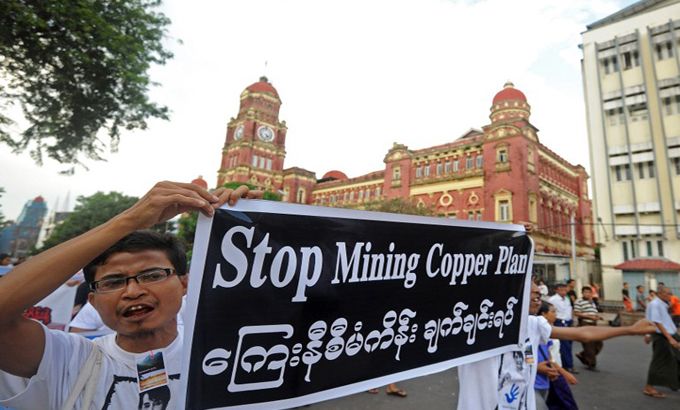Riot police break up Myanmar copper protest
Security forces used a water cannon and other weapons to end the three-month protest, injuring 10 monks, two critically.

Riot police fired water cannons and tear gas to break up a three-month protest against a vast copper mining project run by Myanmar’s powerful military and its partner, a subsidiary of a Chinese arms manufacturer.
“They shot some sort of canisters that caused a fire at the camp. We just don’t know what sort of weapon it was,” Shin Oattama, a Buddhist monk who had helped the villagers, told Reuters by telephone. “We are now seekeing refuge at a nearby village. There’s no ambulance, no doctor to take care of the injured.”
Oattama said that security forces began to use water cannon and other weapons at about 3:00am [2030 GMT], wounding 10 monks, two of them critically.
Witnesses said truckloads of police arrived at camps near the mine in the Sagaing region in Myanmar’s northwest, where thousands have demonstrated against a $1bn expansion of the project, which they say has caused the unlawful confiscation of more than 7,800 acres (3,160 hectares) of land.
Myo Thant, a member of the 88 Generation Students Group who has been monitoring the situation in Monywa, said: “Police used tear gas canisters. Gun shots were not heard… nobody knows for sure how the fire started.”
Right to protest?
After decades of oppression, the Monywa mine has become a test of Myanmar’s commitment to reform as protesters probe new-found freedoms, including a relaxation of laws on protests that took effect in July.\
“This is an example of the skin-deep nature of Burma’s reforms,” said Mark Farmaner of the London-based advocacy group Burma Campaign UK. “The new right-to-protest law was hailed as a major reform but it is clear there is still no right to protest in Burma.”
Authorities warned the protesters late on Tuesday to clear the site by midnight that day so that a parliamentary commission could carry out an investigation.
State television said all project work had been halted since November 18 because of the protests.
The mine, Myanmar’s biggest, is run by a unit of China North Industries Corp, a leading Chinese weapons manufacturer, under a deal signed in June 2010 after Canada’s Ivanhoe Mines Ltd pulled out in 2007. It is backed by the military-owned Union of Myanmar Economic Holdings Ltd (UMEHL).
UMEHL operated with impunity under the military regime that ruled Myanmar for almost half a century until 2011.
The mine protest also illustrates growing resentment towards Chinese companies that have expanded in recent years across the country.
The Global Times, an influential tabloid published by China’s Communist Party mouthpiece, the People’s Daily, said in an editorial published on Thursday it would be a “lose-lose situation for China and Myanmar if the project is halted”.
“Only third parties, including some Western forces, will be glad to see this result,” it said, blaming “some Westerners” and non-government organisations for instigating the protests.
“We must not give up on the project. Even if it is eventually stopped, Chinese companies should receive compensation according to the contract and international practice,” it said.
Protest reforms
Protests were suppressed quickly under a military junta in place until last year, but have become more common as president Thein Sein opens up the country, also known as Burma, and pushes through reforms.
Land disputes are a growing problem in Myanmar. Protests stretching back at least three months have involved thousands of locals and supporters. They told Reuters in September that four of 26 villages at the project site had already been displaced, along with monasteries and schools.
Aung San Suu Kyi, a Nobel Peace laureate and a member of parliament, was going ahead with a scheduled visit to the site on Thursday, her National League for Democracy (NLD) party said.
She intended to speak to the protesters about their grievances.
NLD official Ohn Kyaing told Reuters by telephone she had flown to the central city of Mandalay and was going on to Monywa by road.